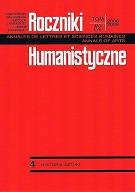Recepcja twórczości Francisa Bacona w sztuce polskiej lat sześćdziesiątych i siedemdziesiątych XX wieku. Rozpoznanie wstępne
Reception of Francis Bacon's Paintings in the Polish Art. Introductory Reconnaissance
Author(s): Karolina ZychowiczSubject(s): Cultural history
Published by: Towarzystwo Naukowe KUL & Katolicki Uniwersytet Lubelski Jana Pawła II
Keywords: Polish art after 1945; Polish painting; Polish sculpture; figuration; New Figuration; nouvelle figuration; Realism; Pop-art; Engaged Art; deformation; grotesque; existentialism; angoisse; Angst; reception; intertextuality
Summary/Abstract: In the mid Sixties New Figuration appeared in Poland. Researchers interested in this chapter of polish art consider the reception of Francis Bacon’s paintings as one of the sources of this kind of art. The subject of this article is mainly the painters, whose works show this reception, but also the sculptors. It concentrates on the Sixties and Seventies in Polish painting. (...) In the second half of the Sixties we can find the inspiration of Francis Bacon’s art in the paintings of Janusz Przybylski (1937-1998). Bacon in his compositions used spatial frame which was interpreted in different ways. It had been seen as a usual glass cage, confined the human being. The artist admitted that he uses this endeavour to expose a man in a better way. This solution became a kind of an artistic hook and it was taken by other artists. It spread so much that it became a kind of a manner. To avoid narration Bacon sometimes used a form of triptych. This was typically used by him and was imitated almost as often as placing people in a spatial frame. Both hooks were used by Przybylski, whose art in a different way fits in as a style of existentialism. The deformed human beings in the cages should show alienation and the drama of man. This aspect of polish artists’ paintings more than others highlights connections with the English master’s art. The polish painter of the Sixties and Seventies was not an artist who could be described as self-sufficient from what we can see by viewing their paintings and reading art critics. (...) Bacon happened to be a very popular artist in Poland in the Sixties and Seventies which corresponds with general trends in European art. At this time came after return to show a human being. It appeared New Figuration, antidote on the Abstraction, Conceptual Art. and metavisual experiments of the Sixties. Bacon became the father to these new phenomena in art because he brought about a renewed artistic imagination and created a new image of the human being. Moreover, Bacon was regarded as a main representative of art identified with existential philosophy. This painting in a very good way expressed spirits of the time. It reflected Zeitgeist, that climate which was then best shown in the philosophy of existentialism. Bacon’s reception in Poland had also local color. English artist’s art was assimilated by polish painters, who were interested in politics, what was unfamiliar with Bacon who concentrated on universal problems. It seems that polish artists like thematic art, taking problems concerning a human being and his immediate environment, what constitutes the heritage of our history.
Journal: Roczniki Humanistyczne
- Issue Year: 57/2009
- Issue No: 04
- Page Range: 55-79
- Page Count: 25
- Language: Polish

